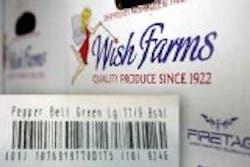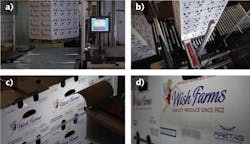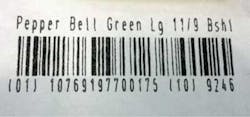Laser marking answers the call for fresh produce traceability
by Steven Coomber, Fujifilm Hunt Chemicals
In recent years, there has been a seemingly ongoing stream of bacterial outbreaks and product recalls around the globe within the packaged and delivered grocery item industry. From straight-from-the-field produce to processed and packaged dry goods, identifying and tracking these products is of paramount importance. Unquestionably producers and distributors need to have a process in place to track the goods that move through their facilities. Federal law mandates that each company be able to track goods one level down and one level up the supply chain, all the way from the producer of the raw materials to the end consumer.
The North American produce industry is proactively addressing these challenges through the Produce Traceability Initiative (PTI), which requires all cases to be labeled with human readable and GS128 barcode elements. Each case marking must contain the product description and a lot code that will allow traceability throughout the supply chain. The information included beyond the basic PTI requirement is up to the individual company, but the more detail recorded, the more specific a product recall can be. Compliance of fresh produce suppliers with PTI during 2012 will provide a standardized electronic traceability system that is quick, efficient, and reliable.
How to mark a case of lettuce
Implementation of PTI is simple in theory: get the relevant information on the case at some point in the picking and packing process. Taking a page from the manufacturing sector's book, the solution might appear as easy as using "print-and-apply" labeling systems, based on continuous inkjet or thermal transfer onto self-adhesive labels, normally combined with a label applicator.
Unfortunately, the drawbacks of using print-and-apply labels in a produce venue quickly become apparent. Industrial production lines have the advantage of being automated, located indoors with a full complement of utilities, and staffed by skilled and semi-skilled labor within the confines of a tight, pre-determined schedule. Contrary to this, the produce process is conducted both indoors and outdoors, in varied and remote locations, by unskilled labor, and its timetable is dictated by both seasonal and daily weather conditions. Therefore, the label solution suffers from a number of issues:
- Logistics of sourcing, printing, and delivering labels
- Cost and inconvenience (including shipping and storing) of on-site consumables
- Resultant waste disposal of ink and ribbon cartridges and label release liners
- Determining where (physically) and at what stage (temporally) in the operation they will be printed
- Labor required for label application -- both manpower and training are necessary to get the labels placed consistently and with the correct orientation, and the inherent inconsistent flow of product results in periods of high activity followed by periods of inactivity, creating cost inefficiencies
- Over-printing of labels and the waste costs incurred
- Under-printing of labels and the loss of output incurred (or the cost of emergency printing activity)
- Inefficiency of a two-step process (print and apply)
- Myriad adhesion challenges:
- Insufficient application pressure
- Case surface inconsistencies
- Case material moisture content, including effects of high humidity and inclement weather
- Quality of the label or adhesive
- Further "processing" of the case -- food products often need to be cooled or frozen to preserve freshness, meaning cases can be exposed to blast freezers blowing at arctic-like temperatures and hydro-coolers cascading cold water over them
- Missing labels can lead to costly full pallet or full load rejections from customers
- Boxes rubbing together in transport can damage or remove labels
Merely adopting what other industries had implemented was clearly not the optimal resolution.
A grower's experience
Wish Farms' (Plant City, FL) history in the produce industry goes back to the early 20th century. Today the company is, among other accolades, Florida's largest grower and shipper of strawberries. It also participates in PTI.
When Wish Farms began looking at PTI compliance, it first addressed the issue of where in the process would be the most logical point to make the mark. Marking in the field was deemed untenable due to the aforementioned complexities and drawbacks. However, the company acknowledged that marking after the goods were returned from the field to the warehouse would make it necessary to apply marks on the cases after being palletized.
Using print-and-apply labels was also considered, but rejected -- Wish Farms concluded that labels had to be eliminated from the process. No labels means no issues with them peeling off. Without labels being applied, there is no need to manage a labeling workforce, so the factors associated with human error are gone. Cases can go through the entire operation without losing a single label and leave the facility properly marked.
To better understand its options, the company turned to 4FX Design, experts in mechanical design, electrical engineering, and specialized Internet-enabled software for difficult and unique automation projects. Bob Pitzer, principal at 4FX, saw conceptually what was required: An ecologically sound, automated system to reliably apply marks to palletized cases, with minimized interruption of time and energy to the flow of the picking and packing process, and no additional manual labor or consumables.
Traditional case marking usually consists of cases moving past a stationary printhead, as on an assembly line. This was not an option for 4FX because the system had to deal with pre-palletized cases. Consequently, the firm envisaged a design whereby the pallet remains static, but the marking mechanism moves. The next decision was determining which marking technology to use. Inkjet printing was deemed unacceptable; inkjet marking suffers from reliability problems (nozzle clogging, etc.), is sensitive to the spacing between the printhead and the case, and -- most damning -- requires consumables.
4FX Design already had familiarity with lasers from previous projects. "Knowing their speed and reliability characteristics, we gravitated toward a solution that incorporated a CO2marking laser," noted Pitzer. Knowing that a scribing laser can mark directly on a case surface, but the result is not machine-readable, "we needed a way to make a mark with enough density for a scanner to successfully read the barcode," he said.
Pitzer and 4FX design determined that CodeStream, an aqueous laser-markable coating from Fujifilm Hunt Chemicals USA Inc., was the key to meeting this requirement. This proprietary technology is designed to mark variable data on a wide variety of packaging materials to allow the late-stage recording of lot numbers, expiry dates, and product information. CodeStream is applied to packaging substrates during the printing process; on substrates such as labels and corrugated cardboard it dries to a translucent-white appearance, and when activated with CO2 laser energy (wavelength in the range of 9.3-10.6 μ) the affected area changes to black (Figure 1). The CodeStream mark is highly resistant to environmental and contact damage, including scuffing, scratching, temperature extremes, and water.
"We commissioned a trial to obtain case material with patches of CodeStream coated on it," Pitzer explains. "When that proved encouraging, everything started to come together. What resulted was the FireTag laser marking system."
The laser solution: FireTag
FireTag marks cases with all the necessary PTI information (including human-readable elements and GS128 barcodes) with minimal human interaction, adjusting for varying items and quantities, pallet by pallet. The system identifies product type, pack size, lot, case configuration, as well as other information, and relays it all to the laser which "brands" the information in any order onto the cases. It is modular and fully customizable to meet the needs of a specific company's processes.
Everything starts with the manufacturer of the corrugated cardboard cases, where a patch of CodeStream laser markable coating is applied during production. This patch -- essentially the marking area -- is applied in a manner similar to the ink that prints the graphics, logos, and other generic corporate information on the case. When the cases arrive at the grower's facility, the marking area is already on the containers and ready to be marked.
Produce is picked and loaded into the cases, which are palletized in the field and moved to the location of FireTag, usually a central warehouse. The pallet is loaded onto the fully automated unit where the system "reads" the pallet tag and assimilates the information needed to mark the case (Figure 2). A camera-guided laser moves to identify the CodeStream patch and marks the case before moving on to the next. After one side is complete, the pallet is automatically rotated to mark the other sides.
Seeking the fastest mark time possible, Pitzer chose the KIP-1080 SHS Plus CO2 laser from ID Technology (Fort Worth, TX). This model features an 80-watt laser tube with an output approaching 100 W. To suitably benefit from this amount of power, the mirrors need to move extremely fast, which is achieved with "Super High Speed" (SHS) galvanometer mirrors. The hardware is integrated with ID Technology's Marca graphics software, which enables FireTag to first create the mark message and then send it instantaneously to the laser. Another attribute is that this laser is air-cooled, requiring no separate chillers. Each mark is completed in a mere 350 milliseconds. The marking parameters are: power 100%, frequency 95%, resolution 20%, and mark speed 3700-4500 mm/s. An entire pallet of cases can be marked in less than a minute.
How it's working for Wish Farms
Rob Ogilbee, CFO at Wish Farms, feels Firetag is precisely the answer to the PTI challenge the company was seeking. "PTI is ultimately all about traceability. Not only can Firetag create marks in a reliable, automated fashion with a minimum of additional labor, but the software allows us to capture, record and recall all of the information PTI requires," he says. "The CodeStream patch continues to be readable in all temperatures and other environmental conditions."
He also underscores some other less-obvious benefits: "FireTag never calls in sick, stops working because labels haven't been printed, creates a payroll expense for idle time, or generates a mark that will peel off." Man-hours are saved that might be otherwise dedicated to tracking product flow, label inventory, and managing labor, he points out.
4FX's Pitzer feels there are opportunities in the packaging realm of other industries outside of PTI. "Because of the modular design, FireTag is easily adaptable to any situation where palletized marking is sought," he says. "It can be configured to complement existing packaging lines, or integrated into the plans of new operations."
Steven Coomber ([email protected]) is marketing manager, business development group, Fujifilm Hunt Chemicals USA Inc., Allendale, NJ. Author acknowledges the collaborative contributions of others. Learn more about the elements and players involved with this laser marking application: Firetag, Fujifilm CodeStream, ID Technology Lasers, and The Produce Traceability Initiative (PTI).



